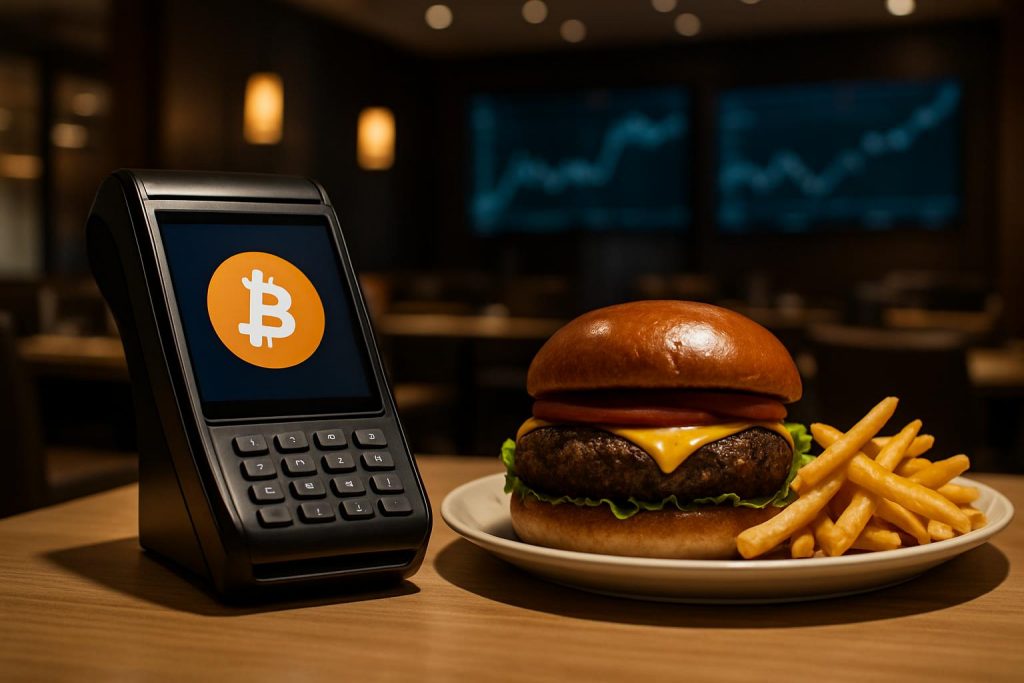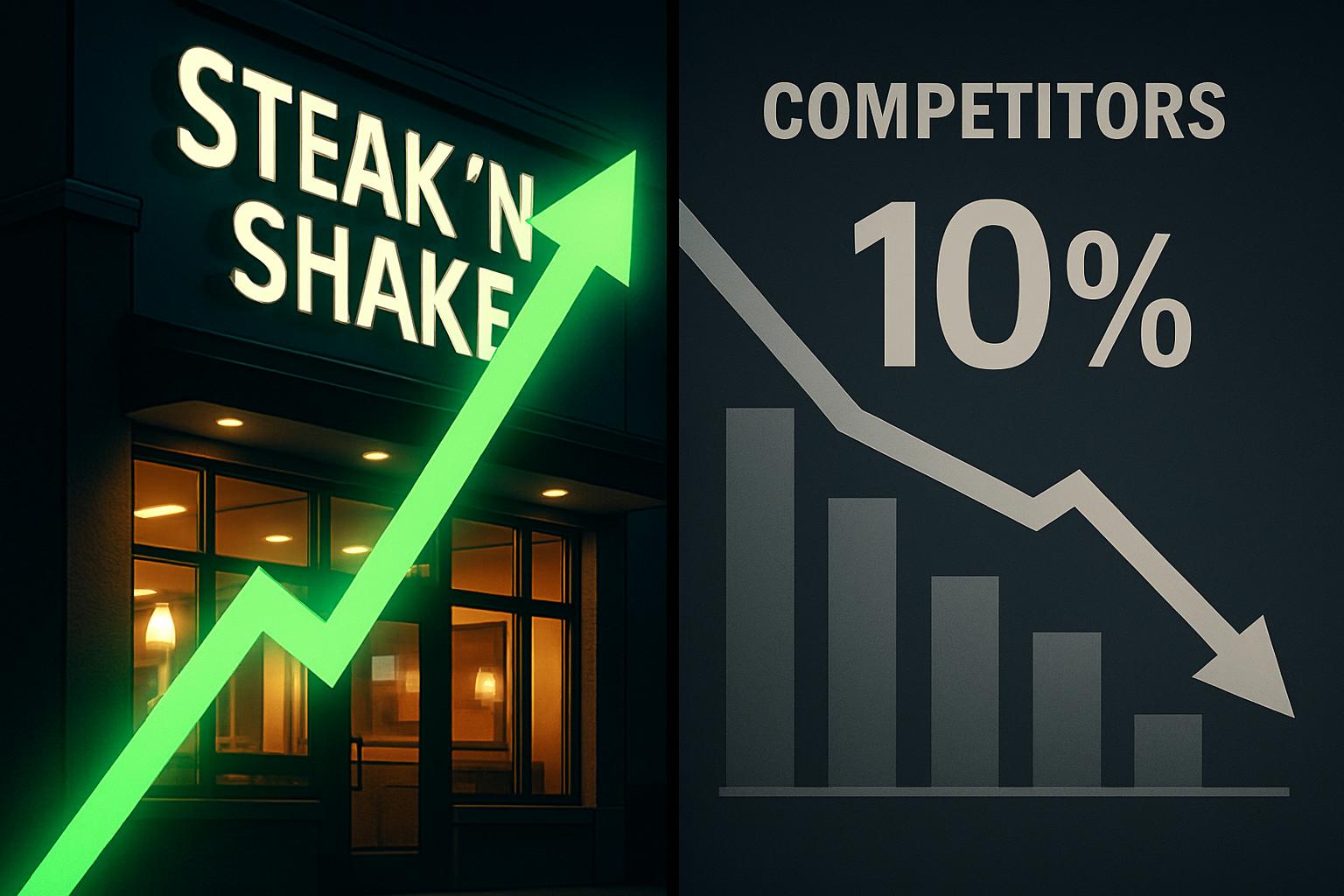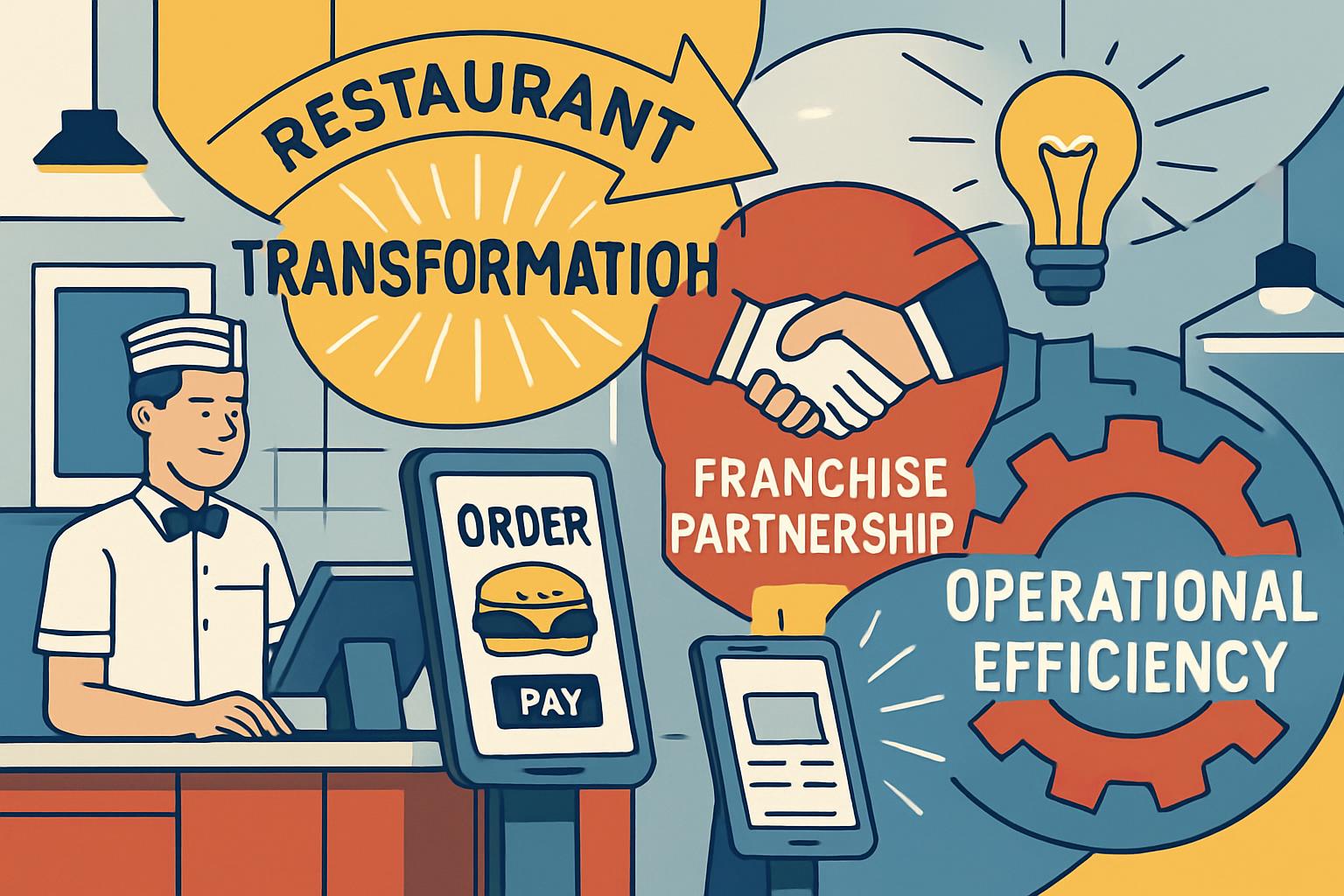Bitcoin, Beef Tallow, and the Bottom Line: A Deep Dive into Steak ‘n Shake’s Remarkable Q2 Turnaround

Executive Summary
Steak ‘n Shake, a subsidiary of Biglari Holdings (NYSE: BH.A; BH), reported a market-defying 10.7% increase in same-store sales for the second quarter of 2025, a performance that dramatically outpaced struggling industry peers. The company publicly attributed this success to its mid-quarter adoption of Bitcoin as a payment method, hailing it as a “game changer.” However, a deeper analysis reveals a more complex and strategically nuanced reality. The sales surge was not the result of a single initiative but rather the culmination of a multi-year, high-risk operational overhaul that was already delivering positive returns. The introduction of Bitcoin, while operationally beneficial, functioned primarily as a powerful marketing accelerant and a masterstroke of brand repositioning, converging with a concurrent and heavily marketed switch to beef tallow-cooked french fries. These initiatives successfully energized distinct and passionate consumer demographics. Critically, this top-line triumph is overshadowed by a severe contraction in the parent company’s pre-tax operating earnings, which plummeted by over 80% year-over-year. This raises fundamental questions about the profitability of the company’s growth strategy and the long-term sustainability of its recovery. For investors and industry observers, the Steak ‘n Shake story is less about the transactional utility of cryptocurrency and more a case study in the power of a multifaceted turnaround strategy, the shrewd execution of asymmetric marketing bets, and the persistent challenge of converting revenue momentum into bottom-line value.
A Quarter of Contrasts: Analyzing Steak ‘n Shake’s Market-Defying Growth
In a fiscal period described by industry analysts as a “brutal time for restaurants,” characterized by waning consumer spending and intense competitive pressure, Steak ‘n Shake delivered a performance that can only be described as an anomaly. The company’s results stand in stark contrast to the broader quick-service restaurant (QSR) sector, demanding a rigorous examination of the underlying drivers of its success and the quality of its reported earnings.
Deconstructing the Headline Number
In its official second-quarter 2025 filing, parent company Biglari Holdings disclosed that Steak ‘n Shake achieved a 10.7% increase in same-store sales across both its company-operated and franchise-partner locations. This figure, often rounded to 11% in media reports, represents a significant acceleration in a challenging economic environment where many competitors struggled to maintain positive growth.
Outlier Performance in a Stagnant Sector
The 10.7% growth figure is particularly striking when benchmarked against industry leaders. During the same period, the QSR landscape was littered with stagnant or negative results, as detailed in reports about low-income consumers curtailing discretionary spending. Data compiled from various industry reports illustrates Steak ‘n Shake’s exceptional position.
Table 1: Q2 2025 Same-Store Sales Growth Comparison (Major QSR Chains)
| Restaurant | Same-Store Sales Growth | Source |
|---|---|---|
| Steak ‘n Shake | +10.7% | Biglari Holdings Q2 2025 Filing |
| Domino’s | +6.1% | Cointelegraph Analysis |
| Shake Shack | +1.8% | Shake Shack Q2 2025 Results |
| McDonald’s | -7.1% | Industry Peer Comparison |
As the data indicates, Steak ‘n Shake did not merely perform well; it achieved a level of growth that was orders of magnitude greater than its rivals, transforming it from a struggling legacy brand into the sector’s top performer for the quarter. This outlier result immediately begs the question of causality: what strategic levers did the company pull to engineer such a dramatic divergence from market trends?

The Parent Company Paradox: Soaring Sales, Shrinking Operating Earnings
While the top-line sales figures paint a picture of resounding success, the consolidated financial statements of Biglari Holdings reveal a far more troubling narrative. The holding company reported a significant swing in net earnings, posting a $50.9 million profit in Q2 2025 compared to a $48.2 million loss in the prior-year period.
However, this profitability was not driven by the underlying restaurant business. It was almost entirely attributable to $61.4 million in investment gains. Biglari Holdings itself cautions investors that these fluctuations are “not meaningful for analyzing the performance of its operating businesses.” The more telling metric—pre-tax operating earnings—collapsed, falling from $19.7 million in Q2 2024 to a mere $3.7 million in Q2 2025, an 81% decline.
Table 2: Biglari Holdings (BH) Q2 2025 vs. Q2 2024 Key Financials (in thousands)
| Metric | Q2 2025 | Q2 2024 | % Change |
|---|---|---|---|
| Pre-tax operating earnings | $3,673 | $19,704 | -81.4% |
| Investment gains (losses) | $61,429 | ($82,619) | N/A |
| Net earnings (loss) | $50,931 | ($48,190) | N/A |
Source: Biglari Holdings Inc. News Release
This stark divergence between surging sales and plummeting operating profit is the central paradox of Steak ‘n Shake’s quarter. In the restaurant industry, which has significant fixed costs such as rent and utilities, strong same-store sales growth should theoretically lead to margin expansion through operating leverage. That the opposite occurred so dramatically suggests that the cost of achieving this 10.7% growth was exceptionally high. The data points toward a strategy that, while effective at driving customer traffic and revenue, has severely compressed profitability, raising critical questions about its long-term financial sustainability.
The Bitcoin Gambit: Operational Efficiency Meets Marketing Masterstroke
Steak ‘n Shake’s public narrative credits its Q2 success to its decision to embrace Bitcoin. While the initiative delivered tangible operational benefits, its true value appears to lie in its function as a brilliantly executed marketing and brand-repositioning campaign that captured the attention of a global, digitally-native community.
The Mechanics of Adoption
On May 16, 2025, Steak ‘n Shake began accepting Bitcoin payments at all locations where legally permitted, including its primary U.S. market as well as international outposts in France, Monaco, and Spain, a move that Cointelegraph reports made crypto payments available to over 100 million customers.
Critically, the implementation leverages the Bitcoin Lightning Network, a Layer-2 protocol detailed by Bitcoin Magazine as designed for near-instantaneous, low-cost transactions. This technical choice was essential, as it directly addresses the primary criticisms of using the main Bitcoin blockchain for small-value retail purchases—namely, high transaction fees and slow confirmation times—making it a viable point-of-sale solution.
Tangible Benefits: The Cost-Savings Argument
The most direct financial advantage cited by the company was a significant 50% reduction in payment processing fees compared to traditional credit card networks. At the Bitcoin 2025 conference in late May, Steak ‘n Shake’s Chief Operating Officer, Dan Edwards, highlighted this efficiency gain, framing the initiative as a multi-win scenario: “This means that Bitcoin is a win for the customer, it’s a win for us as the merchant, and it’s a win for you in the Bitcoin community”. In the notoriously low-margin QSR industry, such a substantial reduction in a key variable cost represents a meaningful operational improvement, even if applied to a small fraction of total transactions.

Intangible Impact: A “Game Changer” in Marketing and Brand Perception
Despite the cost savings, the primary return on the Bitcoin investment appears to have been in marketing and brand perception. The company’s own social media account on the platform X called the move a “game changer” and explicitly thanked “Bitcoiners” for their support, signaling a deliberate effort to engage with and cultivate a specific, passionate community, as noted by Restaurant Business Online.
The timing of the launch—May 16—is a crucial analytical point. Occurring nearly halfway through the second quarter, its direct, cumulative impact on the full quarter’s transaction volume was inherently limited. Its greater effect was as a catalyst for media attention and public discourse. The announcement generated a wave of positive coverage in both cryptocurrency-focused and mainstream financial media, providing the company with extensive free marketing and, as Bitget News highlights, instantly rebranding the legacy chain as a forward-thinking innovator.
The initial response from the target community was immense. On its first day of accepting Bitcoin, Steak ‘n Shake’s transactions accounted for a remarkable 0.2% of the entire global Bitcoin network’s activity. While this metric was clearly a one-off spike driven by novelty, it serves as a powerful indicator of the campaign’s success in mobilizing the crypto community and generating an outsized public relations impact. For a struggling brand, this initiative was a successful act of “narrative arbitrage”—leveraging the powerful cultural momentum of a bullish Q2 2025 crypto market, which saw Bitcoin reach new all-time highs according to Bitwise Investments, to fundamentally reshape its own public image at a relatively low cost.
The Anatomy of a Comeback: Unpacking the Confounding Variables
Attributing the entirety of a 10.7% sales surge to a payment system introduced mid-quarter is an oversimplification. The data reveals that the Bitcoin initiative was an accelerant poured onto a fire that was already burning. The true story of Steak ‘n Shake’s Q2 success is one of a multifaceted turnaround strategy, years in the making, that was already yielding significant results.
The Beef Tallow Effect: A Calculated Appeal to a Core Demographic
Months before the Bitcoin announcement, in February 2025, Steak ‘n Shake executed another major strategic shift: it began cooking its french fries in 100% beef tallow. The company marketed this change heavily as a return to “authentic” flavor and higher quality, moving away from the vegetable-based seed oils used by most of the industry.
This move was a calculated appeal to a specific and growing consumer segment concerned about the health impacts of processed seed oils. The initiative gained significant traction and was publicly praised by U.S. Health and Human Services Secretary Robert F. Kennedy, Jr., who aligned it with the “Make America Healthy Again (MAHA)” movement. This endorsement generated considerable attention in conservative media, effectively tying the brand to a potent cultural and political identity and likely driving traffic from a loyal demographic well before the Bitcoin launch.
A Turnaround Already in Motion: The Historical Data
The most compelling evidence against a single-cause explanation for the Q2 surge lies in the company’s own historical performance. The recovery at Steak ‘n Shake did not start in May 2025; it was a well-established trend. As QSR Magazine’s analysis shows, the company had been posting consistent, and often strong, positive same-store sales growth for more than a year prior.
Table 3: Steak ‘n Shake Same-Store Sales Growth (Q1 2024 – Q2 2025)
| Quarter | Same-Store Sales Growth |
|---|---|
| Q1 2024 | +9.9% |
| Q2 2024 | +7.0% |
| Q3 2024 | +5.4% |
| Q1 2025 | +3.9% |
| Q2 2025 | +10.7% |
Source: QSR Magazine analysis of Steak ‘n Shake’s performance
This data is critical. It demonstrates that the 10.7% growth in Q2 2025 was not a reversal of fortune but a dramatic acceleration of an existing positive trajectory. This context reframes the central question from “What caused the turnaround?” to “What caused the turnaround to accelerate so sharply in this specific quarter?”
The Foundational Overhaul: A New Business Model
The positive sales trend shown above was built upon a painful but necessary reinvention of the company’s entire business model. This restructuring followed a period of severe decline that saw the chain’s footprint shrink from a peak of 628 U.S. stores in 2018 to just 397 by May 2025, a period during which the company flirted with bankruptcy in 2021 before a last-minute rescue by Biglari Holdings.
The overhaul involved two key strategic shifts. First, many locations were converted from a traditional full-service, sit-down model to a more efficient counter-service format utilizing self-service kiosks. Second, the company instituted a novel, low-cost franchise-partner program, allowing operators to take control of a restaurant for a $10,000 investment in exchange for sharing 50% of the profits with the parent company. These foundational changes were designed to improve store-level efficiency, reduce labor costs, and better incentivize operators, forming the operational bedrock upon which the sales recovery was built.
A Case Study in Asymmetric Bets: Synthesis and Strategic Insight
Steak ‘n Shake’s Q2 2025 success was not the product of a single “silver bullet.” Rather, it was a perfect storm, a confluence of strategic initiatives where a stabilized operational base, a culturally resonant product innovation, and a high-profile technology adoption amplified one another to produce an extraordinary result.
The Confluence of Factors
The 10.7% growth is best understood as a layered phenomenon. The fundamental operational restructuring created a stable platform and initiated a positive sales trend beginning in early 2024. The switch to beef tallow fries in February 2025 served as a powerful product- and marketing-driven catalyst, resonating with a specific consumer tribe and driving traffic throughout the first half of the quarter. Finally, the Bitcoin launch in May acted as a second-stage booster, injecting a fresh wave of novelty and media attention that attracted a different, tech-savvy demographic, sustaining and accelerating momentum through the end of the quarter. No single factor in isolation can adequately explain the magnitude of the result.
Bitcoin as an Asymmetric Bet
For a company that had recently stared down insolvency, the Bitcoin initiative represented a classic asymmetric bet—a strategic wager where the potential upside far exceeds the potential downside.
- Limited Downside: The costs were largely confined to the technical integration of a new payment processor and minimal operational risk.
- Massive Upside: The potential rewards were uncapped. They included the tangible 50% fee reduction but, more importantly, the invaluable global media exposure, the repositioning of an aging brand as an innovator, and the opportunity to capture the loyalty of a vocal and digitally-native customer segment.
The strategy’s success lies in its willingness to embrace cultural and technological “wedge” issues to build a coalition of passionate consumer tribes. Rather than competing in the crowded mass market, Steak ‘n Shake pursued a more targeted approach. The beef tallow fries appealed to traditionalists and a health-conscious subculture, while Bitcoin adoption appealed to technologists, libertarians, and younger consumers. By authentically catering to these distinct groups, the company forged a brand identity that stands for something more than just burgers and fries, creating an emotional resonance that drove both traffic and loyalty.

The Road Ahead: Sustainability, Replicability, and Investor Implications
The remarkable success of Steak ‘n Shake’s second quarter raises crucial questions about the future. While the company has demonstrated an ability to generate explosive top-line growth, the path forward is fraught with challenges regarding profitability, the sustainability of its newfound momentum, and the replicability of its strategy for the wider industry.
For Steak ‘n Shake: Can the Momentum Be Sustained?
The primary challenge for Steak ‘n Shake is to prove it can translate sales growth into bottom-line profit. The precipitous decline in pre-tax operating earnings is a significant red flag, suggesting the current strategy is value-destructive from a margin perspective. Management must now demonstrate it can normalize marketing expenditures and manage food costs while retaining the new customers acquired during this high-cost growth phase. Furthermore, the novelty of both beef tallow fries and Bitcoin payments will inevitably fade. The long-term challenge is to convert the trial and excitement generated by these initiatives into sustained customer loyalty through operational excellence and consistent value delivery.
For the QSR Sector: A Replicable Model or a Unique Event?
While competitors will undoubtedly study Steak ‘n Shake’s playbook, the success was highly context-dependent. It involved a struggling brand making a bold, unexpected move during the peak of a crypto bull market. A market leader like McDonald’s adopting Bitcoin today would likely not generate the same degree of surprise or PR value. The key lesson for the industry is not necessarily to adopt a specific cryptocurrency, but to understand the strategic power of asymmetric marketing bets and authentic engagement with passionate niche communities. The goal for competitors should be to find their own “Bitcoin”—a low-cost, culturally potent initiative that signals a core brand value and energizes a loyal base.
For Investors in Biglari Holdings (BH): A Bull or Bear Case?
The Q2 results present a bifurcated narrative for investors, supporting both a bullish and a bearish outlook on the company’s future.
- The Bull Case: Management has proven its ability to execute a creative and complex strategy that can deliver industry-shattering top-line growth. They have successfully revitalized a brand that was on the brink of failure and have demonstrated a keen ability to tap into the cultural zeitgeist to drive consumer behavior.
- The Bear Case: The impressive growth has come at a severe, and perhaps unsustainable, cost to profitability. The company’s reliance on volatile investment gains to report net income masks a deeply troubled operating picture. The long-term investment thesis hinges entirely on whether this newfound sales momentum can be converted into positive and growing operating cash flow.
Until Biglari Holdings can demonstrate a clear path to profitable growth, the risk remains that the celebrated Q2 2025 sales surge was a pyrrhic victory—one that won the battle for headlines but is losing the war for sustainable shareholder value.
Steak ‘n Shake’s bold move to integrate Bitcoin payments underscores a critical takeaway for modern businesses: embracing cryptocurrency isn’t just about technological adoption; it’s a strategic pathway to unlocking new growth. As seen in Steak ‘n Shake’s case, crypto payments can significantly reduce processing costs and attract a dynamic, tech-savvy customer base. For enterprises and online stores ready to tap into this potential, Aurpay offers an enterprise-grade crypto payment gateway designed for speed, security, and maximum cost efficiency. Integrate crypto payments in minutes, potentially saving up to 96% on processing fees compared to traditional methods, and position your brand for the future of digital commerce. Don’t just watch the crypto revolution unfold – lead it in your industry. Explore how Aurpay can transform your business.

